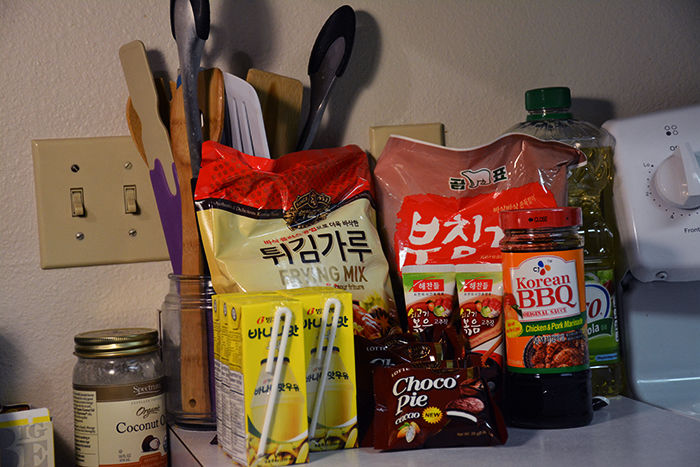Finding ethnic food on the Palouse
Shin’s Asian Market and Phung-Mart, local Asian markets for Pullman and Moscow, provide food from places like China, Japan and the Philippines.
January 23, 2017
{{tncms-asset app=”editorial” id=”6353d0c0-e125-11e6-a924-131d76825081″}}
Last year, my colleague at The Daily Evergreen wrote the article “Campus food does not match diversity of student population.” The premise was simple enough. It was a piece on the desires of the WSU student body for more diverse food options, namely ones to reflect their respective cultures and upbringings.
Surprisingly, the article turned out to be rather divisive. With a long stream of positive and negative Facebook comments, a handful of shares and voiced opinions, whatever one’s thoughts were, the consequences of the article clearly demonstrated something to me: food matters.
Food is universal. It is a kind of common language for people. It doesn’t matter where you are from or whether you can even talk to the person sitting across from you, food is something that brings people together at the table.
This is most often seen in the form of “comfort foods.” These are typically the foods you grew up eating or had a special liking for because it came from your family, a place of love.
In America, these might be your grandma’s pie, dad’s burgers and steaks or mom’s special pasta. These types of foods are labeled “American” and have significant permeation in the everyday restaurants an “American” would go to.
But not every American grew up eating those foods. For many immigrants or international students, being able to eat the foods of their childhood gives them a sense of home or comfort.
Time Magazine published the piece “The Science of Why You Crave Comfort Food” in 2015. The article points to different studies finding that “people with strong relationships preferred the taste of comfort food when they experienced feelings of social isolation.” It wasn’t just food that played a powerful role in our emotions but smell, too. “Nostalgia can be evoked in different ways, but scents may be particularly likely to evoke nostalgia due to the strong link between scents and memory,” the article said.
The fact that food is so closely related to our memories and emotions is a reason people get so defensive over the subject. The reason The Daily Evergreen article invigorated so many people with various opinions is because everyone has their own thoughts about and particular approach to food.
Each of us likes our food made a certain way or expresses irritation when the dish doesn’t taste like how mom used to make it. An unsuccessful variation on a favorite comfort food or even insulting the dishes that we grew up with can feel like a personal attack on our childhoods or our very sense of self.
Food is a part of the building blocks for a person’s identity. Having access to comfort foods is a form of privilege and when you restrict that, you take away something vital about that person.
For international students, here at WSU, it can be challenge. It is already isolating at times moving halfway across the world and hitting the ground running in an environment they aren’t used to. Having comfort foods can give them a sense of peace.
“It’s such a big struggle when I want to cook something Vietnamese, but Walmart and Safeway don’t have the ingredients I need,” said Quin Nguyen, a Vietnamese international student.
Fortunately, there are some places on the Palouse that offer a diverse selection of food options. Shin’s Asian Market is a great little grocery store that has foods and snacks from China, Japan, Korea, the Philippines, Vietnam and more.
“Shin’s is definitely good for the community,” said T.J. Alviz, Filipino American Student Association historian and math major. “It has more than just exotic ingredients to the Palouse, but snacks and other things that someone not seasoned in Asian food culture can enjoy.”
Phung-Mart is a similar Asian grocery store in Moscow. It is a bit smaller but offers some different products than Shin’s.
As far as restaurants go, I’m impressed by Golden Teriyaki’s second menu. All you have to do is ask for the Chinese menu. It is a one-page menu featuring things like lamb hot pot, black bean fish and pig trotter. All of the menu items are much more authentic and a clear specialty of theirs because they taste better than anything on the regular menu.
Sangria Grille in Moscow offers accurate tastings of the flavors of Peru. Birch and Barley also is noteworthy for its New Orleans-inspired menu. While not international, it is something fairly uncommon to find outside of the bayou.
Students should be willing to try foods outside their comfort zones. In the instance you are studying abroad, trying the foods and flavors of different countries can help you get used to what it will be like to stay and eat there for weeks or months at a time. It would also help give travelers a common bond with the local people.
WSU President Kirk Schulz announced a partnership with INTO University Partnerships last fall, a program that will increase enrollment of undergraduate and graduate international students. As WSU embraces an even more diverse campus, it will be critical to welcome them with open arms and for restaurants to welcome them with an open pot of their favorite food.






















